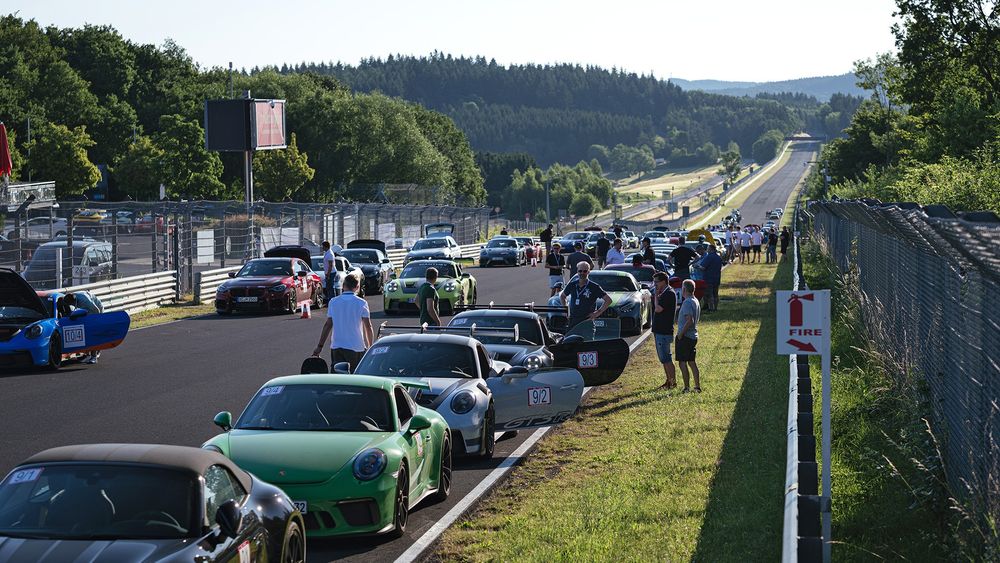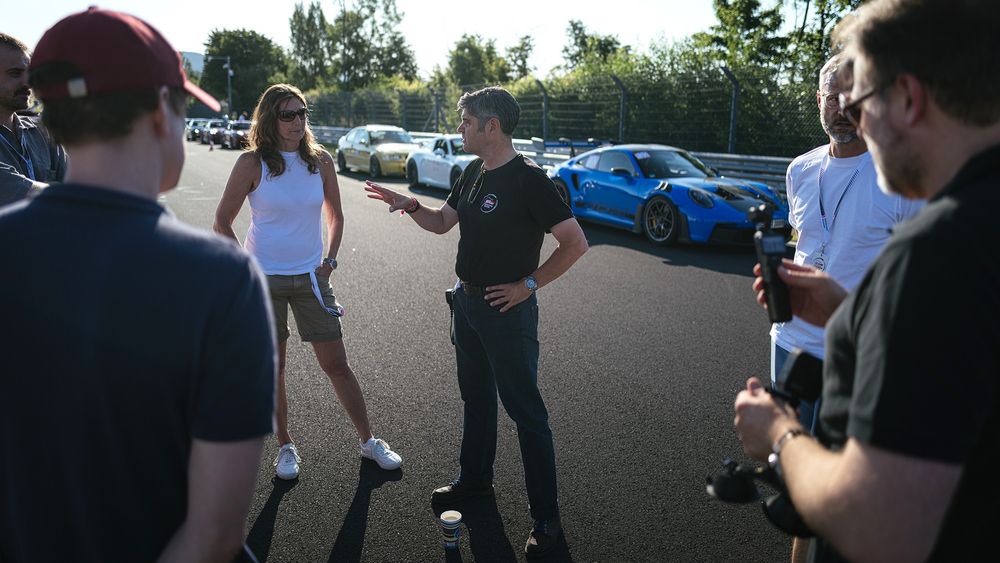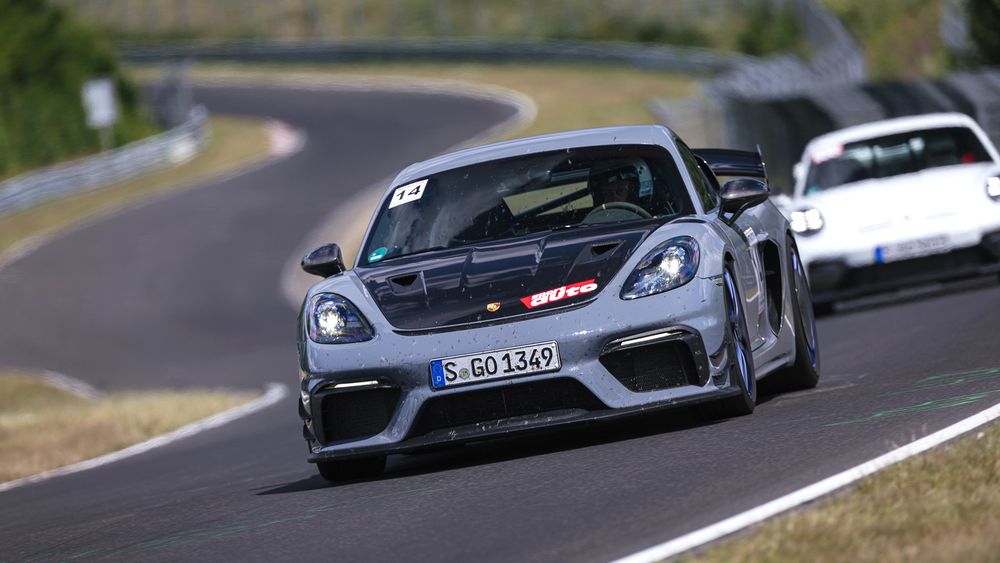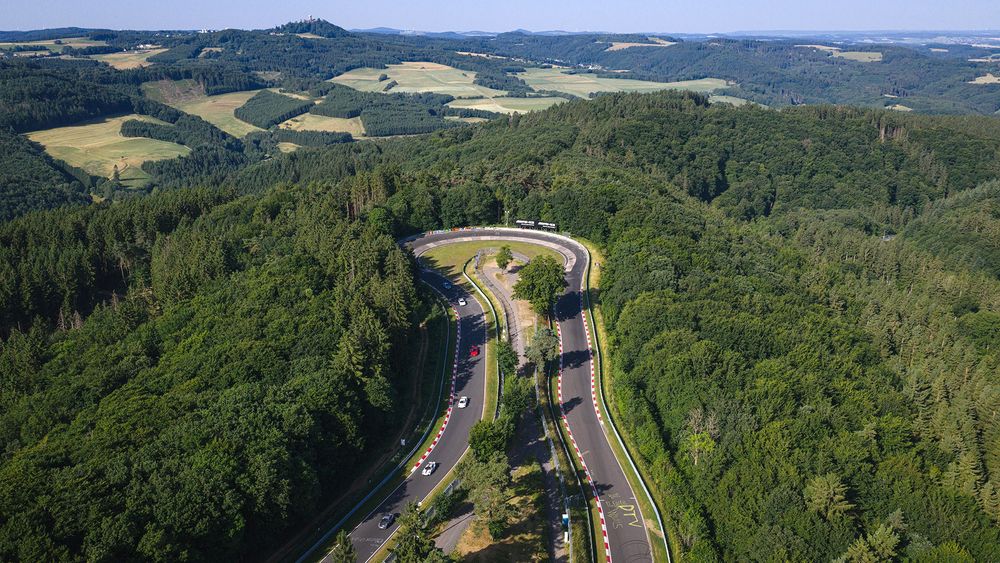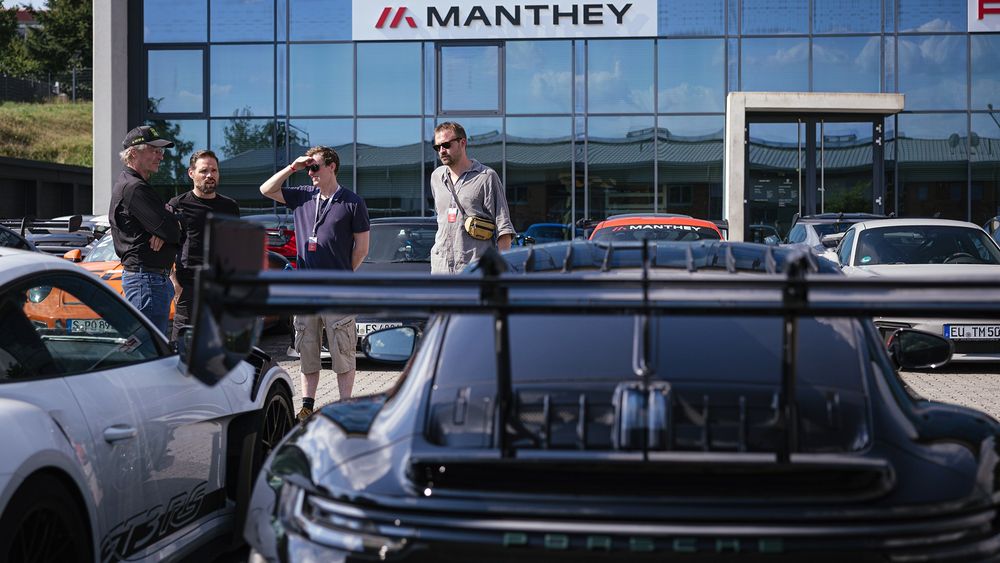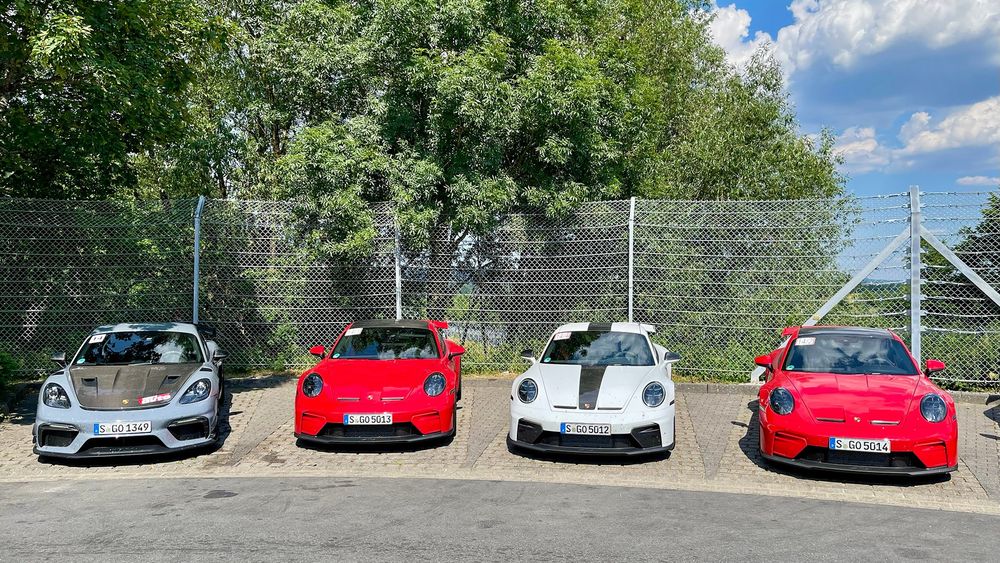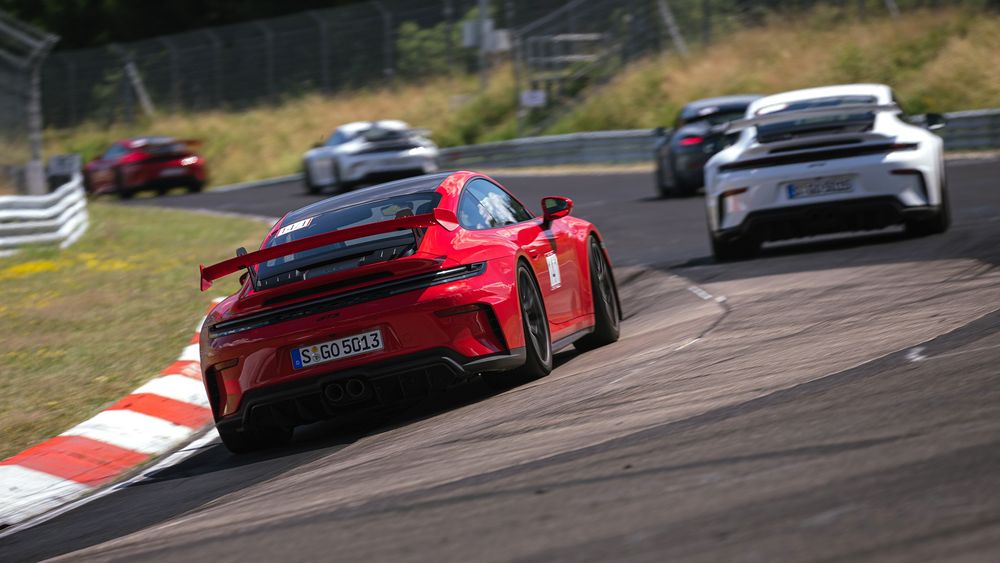How to Drive the Nürburgring, the World's Most Famous and Fearsome Racetrack
Our own Angus MacKenzie learns the fast way around the Green Hell thanks to some Perfektionstraining.
The Nürburgring Nordschleife. The Green Hell. Heroes raced here: Tazio Nuvolari, Juan Manuel Fangio, Stirling Moss, Jim Clark, Mario Andretti, Niki Lauda. And here I am on this fabled tarmac, glued to the tail of Porsche factory test driver Timo Kluck’s Manthey-modded 718 Cayman GT4 RS as we swoop through the big compression at the bottom of the Fuchsröhre, the "Foxhole." I glance at the speedo of the 911 GT3. The needle kisses 145 mph as we arrow through the gentle left and begin the steep uphill climb into the braking area that leads into the tightening right-left at Adenauer Forst.
0:00 / 0:00
That's quick, but not super quick. Porsche’s Jörg Burgmeister touched 170 mph through here on his record-breaking 6:49.32 lap in a 911 GT3 RS a couple of years back. Le Mans 24 Hour winner Timo Bernhard reached a scarcely believable 204 mph in the hyped-up Porsche 919 Evo hypercar back in 2018 en route to stopping the clock at 5:19.55, a record for the 12.94-mile Nordschleife circuit that still stands. But I’ll take it. A couple of days ago, I wouldn’t have had the confidence to check the speedo at the bottom of the Fuchsröhre, much less begin to understand I could get another 10 mph out of the GT3 through it without much risk.
That’s what Perfektionstraining is all about.
Perfektionstraining is a program run by Germany’s Sport Auto magazine that’s held each summer on the legendary Nordschleife, the part of the Nürburgring motorsport complex that comprises most of the old grand prix circuit constructed in the late 1920s. Under the program, Sport Auto has sole use of the Nordschleife for two days from 8:30 a.m. to 4:30 p.m. to enable its instructors to guide groups of up to six cars around the track at high speed to teach them the optimal braking points, the fastest lines through the corners, the right gear to use.
The best bit? Anyone can take part. All you need is a fast enough car and €2,999 (about $3,500 on current exchange rates). An additional driver can share the car for an extra €899 (just over $1,000). And you can even include someone brave enough to ride along on your hot laps for €399 (about $460). In addition to the track rental, the fee pays for safety officials and flag marshals, the attendance of the German Red Cross, help from Bridgestone tire experts, lunch at the famed Pistenklause Restaurant, dinner, and drinks and snacks through the day. It’s a car-guy bucket-list bargain.
Porsche regularly takes part in the Perfektionstraining program, inviting a handful of media and others along to drive one of its current lineup at the event. It’s not hard to see why. Of the 150-plus cars gridding up on this sweltering Tuesday in early July, about 70 percent are Porsches. There’s a handful of classics and a smattering of Caymans—regular coupes and GT4s—but most are heavy-hitting 911s, mostly GT3 and GT3 RS. “This is what our cars are made for,” Porsche director of corporate and product communications Anja Wassertheurer said. “We like to show them in their right environment.”
Wassertheurer isn’t a regular PR face simply spruiking the company line. She worked at Sport Auto testing supercars and sports cars for 15 years before jumping over to the dark side, joining Mercedes-Benz in 2012, a move that meant giving up a racing career that included a class win in a round of the German VLN Endurance Championship at the Nordschleife. She’s been with Porsche since 2016. I’ve met many automotive PRs whose idea of a great drive is nailing the 11th at Augusta. Wassertheurer’s idea of a great drive is a flat-out lap of the Nordschleife in a 911 GT3. The passion is real at Porsche.
Kluck is a bouncy guy with a big grin and a wicked sense of humor. He was born and raised in the small town of Adenau, barely 2 miles from the Fuchsröhre, and knows every inch of the Nordschleife intimately. He’s raced here and tested here for Porsche, with a lap tally that’s now in the tens of thousands. There’s hardly anyone better qualified to show me the right way around the ’Ring.
I’ve driven here before, but it was years ago, and in nothing particularly fast. The first time was in 1992, when big-thinking Toyota Australia execs decided to prove the second-generation Lexus LS400 was as good as any Mercedes-Benz by shipping a bunch of right-hand-drive models to Germany and letting us loose in them on the autobahn and the Nordschleife. I drove maybe 10 laps around the Green Hell that day, the big Lexus getting air in three places as I followed Australian F1 world champion Alan Jones through the trees.
The second time was in 2007, at the wheel of the brand-new six-cylinder Cadillac CTS. On the fifth of my six laps, I kissed the rev limiter in fourth gear entering the Fuchsröhre compression, hitting 127 mph, which was pretty good for a four-door sedan on regular street tires back then. Then I tried fifth gear the next time through and nearly rolled the Caddy into a ball along the guardrail. No track punishes overconfidence like the Nordschleife.
Indeed, just three days earlier, a driver had been killed when his Toyota Yaris GR snapped sideways over the hump midway through the fast Schwedenkreuz sweeper and barrel-rolled into the guardrail. Which is why Kluck warms us up gently, leading us rapidly—but not too rapidly—through the 73 officially declared corners and 1,000 feet of elevation change that make this the most demanding track in the world. He calls the braking points, the turn-in points, and the gear we should be in as we lap behind him, the four journalists swapping around at the end of each lap so each of us could follow right in his wheel tracks.
Learning all those corners takes time, of course—most people reckon you need 50 laps before you really know where you are on the Nordschleife—but learning where the bumps are is also important. Although the track is smoother than it used to be, there are still plenty of sharp undulations that can unsettle a car. The other thing to watch out for is camber changes; there are corners where the road falls away so slightly that you don’t realize it until you feel the car lose grip quicker than you expect.
These are some of the features that make the Nordschleife a favorite test track for automakers developing high-performance cars. I love the sublime feedback the current 911 GT3 delivers through the steering wheel and through the seat of your pants, the razor-sharp response and glorious 9,000-rpm range of its naturally aspirated 4.0-liter flat-six, and the precision of its brakes. But out here, on a lap where speeds range from 45 mph to 165 mph, where corners lurk over blind crests and through gut-crunching compressions, these aren’t just words; they’re tools.
Running fast in close formation (the photos you see here of us are not carefully staged low-speed shots—we’re in the middle of hot laps) gives everyone a great opportunity to not only watch Kluck but also see the 911 GT3 at work on the ’Ring. But just before lunch a dull thud leaves a baseball-sized depression on my car’s windshield, the aftermath of a rock kicked up by the car in front of me at more than 140 mph through the Stefan-Bellof-S. It’s a sobering reminder that there’s a fine line between perfection and mayhem.
Our group’s parking slot is on the straight between the bridge at Antoniusbuche and an Audi-sponsored gantry spanning the track behind us. These are the famed bridge-to-gantry timing points used by enthusiast drivers on days when the Nordschleife is open to all comers who pay €30 to €35—about $35 to $40—to do a single lap as fast as they dare. Here Kluck suggests we swap cars. Back on track it takes just a few corners to realize what a sweetheart the Manthey-massaged 718 Cayman GT4 RS is.
Manthey, whose headquarters are barely a mile away the village of Meuspath, where companies like Hyundai and JLR and Aston Martin also have performance-vehicle development shops, is a race team now 51 percent owned by Porsche. It now also develops and sells kits to make Porsche’s performance 718 and 911 road cars more trackworthy. Manthey’s Cayman GT4 RS kit, for example, includes aluminum-bodied adjustable coil-over shocks, carbon-fiber aero discs for the rear wheels, high-performance copper-infused brake pads, braided brake lines, and a myriad of carbon-fiber aero parts such as bigger rear wing, flics for each front corner, and flow-optimised carbon-fiber underbody hardware.
The 4.0-liter flat-six in the Cayman GT4 RS makes 493 hp at 9,000 rpm, just 9 horsepower less than the version that powers the GT3. Its torque output is identical at 331 lb-ft. The Cayman is just as quick as the 911 GT3 to 60 mph, stopping the clock at 3.2 seconds, and 3 mph faster than its big brother at the top end, able to hit 196 mph. All that, plus the slightly better front-to-rear weight distribution—44/56 percent versus 40/60 percent—and the fact that it’s $60,000 cheaper than the 911 GT3, makes the Cayman GT4 RS arguably the best value factory track day car in the world.
The Manthey GT4 RS feels beautifully balanced on the ’Ring, its limits very approachable. The Manthey kit adds a little more grip through high-speed corners and a little more consistency under hard braking, though the 4.0-liter engine doesn’t sing quite as sweetly to the redline as it does in the 911 GT3.
I swap back into a GT3 for day two and immediately feel something wrong. The brake pedal is longer, to the point where the first time I arrive at Aremberg corner, the tight, decending third-gear right-hander after the super-quick Schwedenkreuz sweeper, I’m wondering if I’ll get the scarlet Porsche slowed enough to make the turn. There’s also a vibration bake through the pedal. I radio my concerns to Kluck. There’s a bit of a pause, then he replies: “Your car has steel brakes.” And they’ve clearly been hammered by the slower journalist who drove the car the day before.
My rock-damaged GT3 was equipped with the $20,020 Weissach package and the $11,070 PCCB carbon-ceramic brakes with black calipers. I’ve never thought the expensive PCCB brake setup was necessary on a road car, but here on the Nordschleife they’re worth every penny, delivering a firm, consistent pedal and unquenchable stopping power, lap after lap after lap. It takes another lap with the steel brakes to recalibrate my braking action, but once I understand the car will still stop when and where I want it, I settle down and get back to concentrating on what Kluck is showing us. Which is just as well, because today he’s noticeably picked up the pace.
After 20 laps the previous day, I’m starting to focus less on where the hell I am in terms of the next corner and more on how to find more speed through it. Yesterday I’d been driving in Track mode but leaving the excellent PDK transmission to figure out the gearshifts for me (for the record, the car was always in the gear Kluck called as being optimal at any given point on the track). Today, I’m shifting manually.
The 911’s electronic brain is now so smart that not even Randy Pobst can outthink the PDK transmission on a track like Laguna Seca. But the Nordschleife is so long and so varied that sometimes you want a different gear to the computer’s selection because it better sets you up for the next two or three corners. For example, short shifting from second to third on the exit of the famed Karussel hairpin steadies the car as it leaps out from the giant banked rain gutter on the inside of the corner.
For the afternoon sessions on day two, the track is fully open, and with just a British journalist and me following Kluck, the pace is getting hotter, both figuratively and literally. The ambient temperature is now a toasty 96 degrees, and we’re having to stop to cool tires that start to feel greasy after two laps on a track whose surface, according to the sign at the entrance, is nudging 130 degrees. But we’ve kept on improving our speed and consistency, Wassertheurer suggesting we’re now lapping at a pace that would get us a bridge-to-gantry lap time (an 11.9-mile lap) of just under eight minutes.
Twenty years ago, you would have needed a hand-built supercar and cojones the size of coconuts to turn a time like that around the Nordschleife. But such has been the pace of powertrain, tire, and electronic chassis control development, it’s doable today in a sporty 911 without sweaty palms and sharp intakes of breath. I’m not kidding myself, though. I’m still nowhere near what this car can do. I hop in alongside Kluck, who in 2013 lapped the full 12.94-mile Nordschleife in under seven minutes in the Porsche 918 Spyder, to find out what a 911 GT3 is like around the Green Hell when driven with serious intent by someone who really knows what they’re doing.
Where he’d been shepherding us through the faster sections like the fearsome Schwedenkreuz, the deceptive sweep down to the second-gear double-apex Wehrseifen kink, and the swoops from Hohe Acht to Brünnchen (a.k.a. YouTube corner because of all the crash videos shot from the adjacent spectator point), Kluck is now pushing, quick little movements on the steering wheel, smooth but strong on the brakes, hard on the gas.
After 36 laps behind the wheel, I’m now familiar enough with both the track and the car to delight in the clarity of the dialog between the two. Kluck is obviously much quicker through the faster corners than me, and the Porsche is moving around much more than it was when I was behind the wheel, but even from the passenger seat I can feel precisely how the slip angles build at each corner of the car.
I left-foot brake, Kluck brakes with his right: “I’m an old guy,” he laughs. But I’m surprised to find that, like me, he hasn’t switched off the stability control. “There’s no need,” he says. “It’s so good.” I suspect, also, that Kluck’s so good that he doesn’t wake up the nannies, as I did—just once—at the Veedol Chicane when I carried a tad too much speed into the right-hander that pinches on the exit and is lined by a hungry wall. At Aremberg, I learn another trick: Kluck switches the drive mode from Track to Sport and leaves it there for the rest of the lap. “Softening the suspension helps the car over the bumps,” he says afterwards. That’s one I’m filing away for next time.
I’m ready to do more laps, but it’s almost 4:30 p.m., and I have a plane to catch out of Frankfurt tonight. Even though it’s done about 440 miles over the past two days with the engine spinning between 7,000 and 9,000 rpm almost the whole distance and the transmission firing off more than 3,200 race-pace gearshifts, my GT3 murmurs contentedly out of the parking lot, ready for a 100-mile drive that will include everyday annoyances like speed cameras and traffic-choked highways. Oddly, I’m quite relaxed about it. After our two days together on the Nürburgring Nordschleife, this Porsche has nothing left to prove.
I can’t remember a time when I wasn’t fascinated by cars. My father was a mechanic, and some of my earliest memories are of handing him wrenches as he worked to turn a succession of down-at-heel secondhand cars into reliable family transportation. Later, when I was about 12, I’d be allowed to back the Valiant station wagon out onto the street and drive it around to the front of the house to wash it. We had the cleanest Valiant in the world.
I got my driver’s license exactly three months after my 16th birthday in a Series II Land Rover, ex-Australian Army with no synchro on first or second and about a million miles on the clock. “Pass your test in that,” said Dad, “and you’ll be able to drive anything.” He was right. Nearly four decades later I’ve driven everything from a Bugatti Veyron to a Volvo 18-wheeler, on roads and tracks all over the world. Very few people get the opportunity to parlay their passion into a career. I’m one of those fortunate few.
I started editing my local car club magazine, partly because no-one else would do it, and partly because I’d sold my rally car to get the deposit for my first house, and wanted to stay involved in the sport. Then one day someone handed me a free local sports paper and said they might want car stuff in it. I rang the editor and to my surprise she said yes. There was no pay, but I did get press passes, which meant I got into the races for free. And meet real automotive journalists in the pressroom. And watch and learn.
It’s been a helluva ride ever since. I’ve written about everything from Formula 1 to Sprint Car racing; from new cars and trucks to wild street machines and multi-million dollar classics; from global industry trends to secondhand car dealers. I’ve done automotive TV shows and radio shows, and helped create automotive websites, iMags and mobile apps. I’ve been the editor-in-chief of leading automotive media brands in Australia, Great Britain, and the United States. And I’ve enjoyed every minute of it. The longer I’m in this business the more astonished I am these fiendishly complicated devices we call automobiles get made at all, and how accomplished they have become at doing what they’re designed to do. I believe all new cars should be great, and I’m disappointed when they’re not. Over the years I’ve come to realize cars are the result of a complex interaction of people, politics and process, which is why they’re all different. And why they continue to fascinate me.Read More

